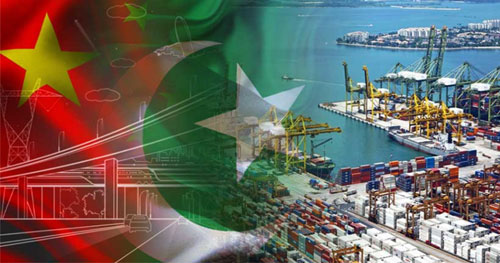Brig (Retd) M.Khan
Ever-since China announced the ‘Belt and Road Initiative’ (BRI) in 2013, two dominant opinions are being debated at international level on this massive global project. The optimists believe that BRI is a unique, incomparable and colossal global project which connects Asia through Eurasian region with Europe and Africa with a lot of promises. This class of international relations’ scholars considers BRI as a mega-project, aiming at improving regional and global connectivity and cooperation through development of communication infrastructure among countries lying on the ancient Silk Road and beyond.
The pessimists on the other hand, visualize BRI from the perspective of growing Chinese influence. This class of political scientists believes in the zero-sum game; the Chinese gain is directly proportional to their losses in the wider arena of international politics. At the global level, the Chinese rise is being viewed with a lot of skepticism by sole superpower and its allies. They see the Chinese rise as a threat to the existing world order, where the superpower has the flexibility of imposing its will, as and when it desires. Nevertheless, so far the Chinese rise has been more pronounced in the economic sphere where the US is its biggest trading partner at the international level while Japan is its major regional trading partner in East Asian region. Even India enjoys the status of a major trading partner of China with over $100 billion bilateral trade annually. This reflects that Chinese rise is peaceful, all-encompassing and beneficial for all. Chinese economic development has been beneficial for the neighbours like ‘a rising tide lifts all boats’.
In the post-cold war era, US/EU have been the leading beneficiaries of Chinese economic development and trade between East and West. As per Office of United States Trade Representative, China is the largest trading partner of US in goods. Besides the US, the EU and China are two of the world’s prime traders. Despite economic cold war between top two economic giants, in November 2019, the US and China agreed to finalize a trade deal which includes rolling back of a portion of the tariffs, which they have been placing on each other’s products. Such a deal would bring an end to the trade war between two global powers, providing opportunities for other states to benefit from the tension-free global economic environment. In the East Asian region, China and Japan are rapidly coming out of the past strategic rivalry through a renewed economic cooperation. After 2012 military build-up both sides have realized that regional rivalry and antagonism is not in favour of any state. Indeed, such an approach has benefitted external power centres while damaging the regional integration.
According to Chinese officials, trade between China and Japan has risen in the last few years, entering into double digit (8.1%) in year 2018. In the same way, bilateral trade between South Korea and China raised by 11.8% in the same period. In a bid to redefining the ASEAN’s economic and security environment through BRI, China has invested over $500 billion in the region in five years from 2014 to 2018. The opportunities through BRI have drastically changed the regional economic outlook and ASEAN’s perception about China. Upon completion of BRI initiated projects, ASEAN’s diverse economies will be reoriented with a new and more vibrant outlook in the broader Asia-Pacific region; the emerging hub of international politics and global economic centres.
In South and Central Asian regions, there are major stakes with regard to BRI. Through BRI the Eurasian Heartland could come out from its global isolation to international mainstreaming. In South Asia, CPEC, the first flagship project of BRI has opened new vistas for the economic development and greater regional cooperation. Upon its completion in 2030, the impact of CPEC will be felt not only in Pakistan and China but, all regional states including those creating hurdles through undesired motives and unfounded bases.
Away from the power politics, under the changing global and regional geopolitical environment, BRI acts as a ladder to attain much needed global peace and much desired economic prosperity by building the long-awaited and essentially vital communication infrastructure. Infrastructural development, as envisaged in BRI is equally needed by developed and developing world. However, BRI is taking extra care of developing world, especially the poor countries.
In today’s world, poverty, underdevelopment and inequality are ostensibly intractable problems, eagerly awaiting sustained and durable resolutions. Indeed, economic development must proceed for addressing the concerns of all those affected. As a mega-project, BRI is aiming to enable grounds for all countries to revamp, modernize and kick start their economies and provide jobs to their unemployed masses for shrinking the angst in order to create an all-inclusive international society. This unexplored dimension of BRI would act as a potential source for reducing the growing trends of militancy and radicalization in the broader Eurasian region, ME and Africa, otherwise considered to be the militancy hit areas. In this way, BRI will be instrumental in bringing peace and cooperation among the communities from different regions of the world for achieving ‘shared growth through collaboration’, the essence of President Xi Jinping’s vision.
Although, we are looking at the brighter promising dimensions of BRI, there are substantial international challenges, confronting this gigantic global project as well. All these challenges can be tackled gradually and through a comprehensive approach of an all-encompassing model. In this socio-economic developmental model, the underdeveloped states must be taken on board while addressing their cultural, religious and nationalistic sentiments. In a nutshell, from the perspective of social constructivism, BRI offers greater prospects for global peace and economic prosperity, therefore, let’s join hands for a peaceful and stable economic order which provides the opportunities for a win-win situation for all. (Courtesy: JISS)










